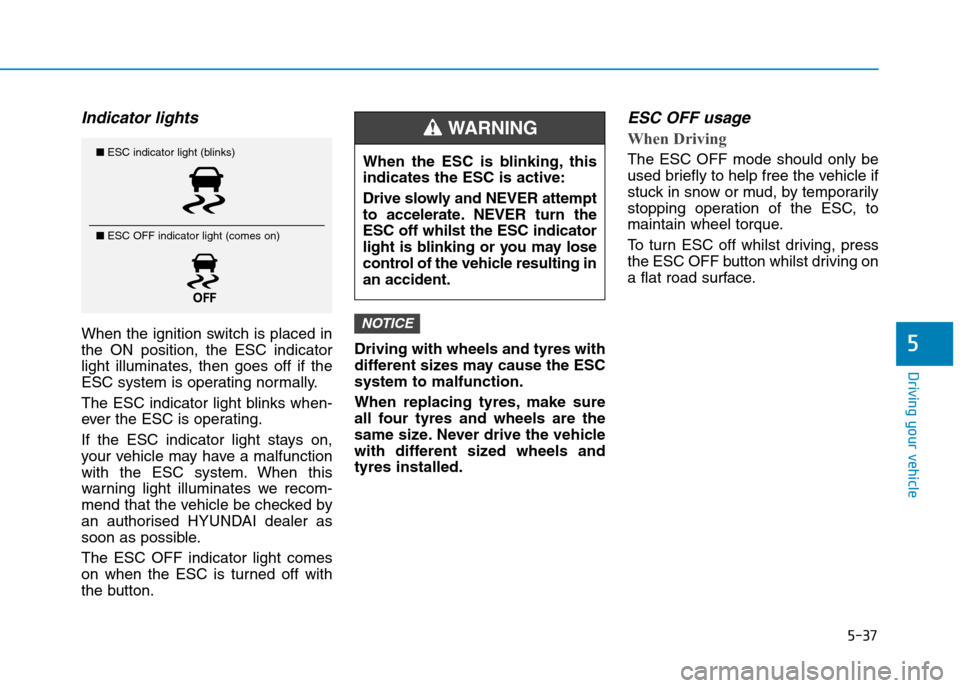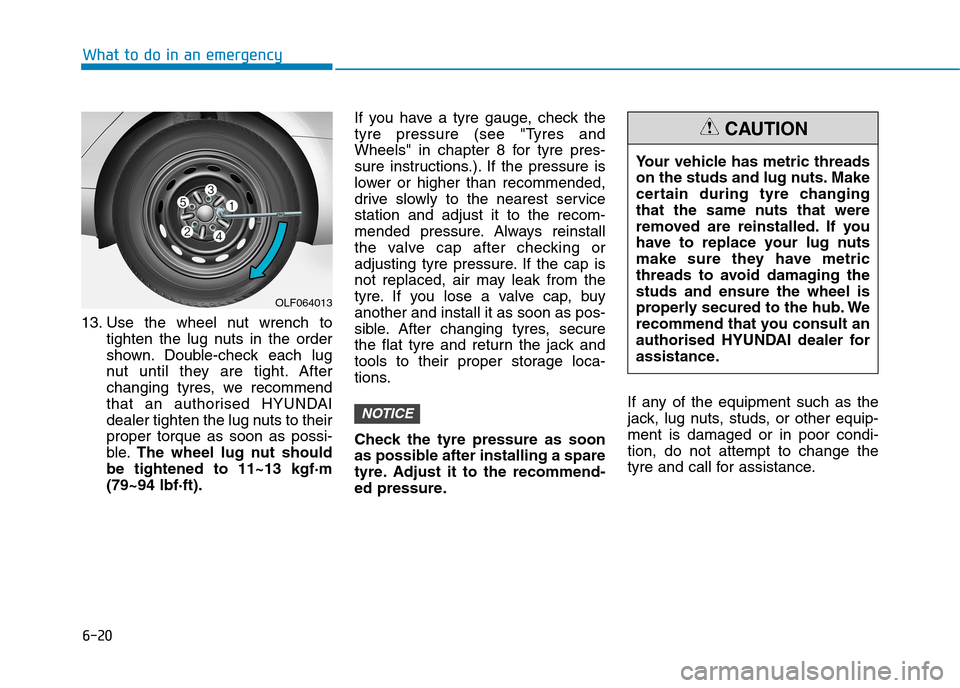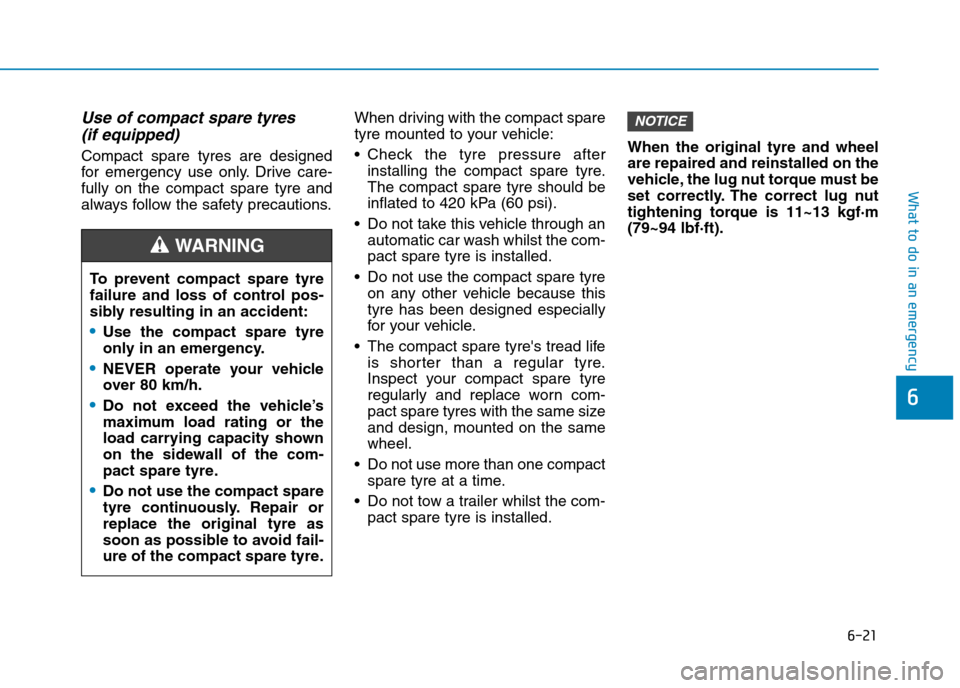Page 413 of 571

5-37
Driving your vehicle
5
Indicator lights
When the ignition switch is placed in
the ON position, the ESC indicator
light illuminates, then goes off if the
ESC system is operating normally.
The ESC indicator light blinks when-
ever the ESC is operating.
If the ESC indicator light stays on,
your vehicle may have a malfunction
with the ESC system. When this
warning light illuminates we recom-
mend that the vehicle be checked by
an authorised HYUNDAI dealer as
soon as possible.
The ESC OFF indicator light comes
on when the ESC is turned off with
the button.
Driving with wheels and tyres with
different sizes may cause the ESC
system to malfunction.
When replacing tyres, make sure
all four tyres and wheels are the
same size. Never drive the vehicle
with different sized wheels and
tyres installed.
ESC OFF usage
When Driving
The ESC OFF mode should only be
used briefly to help free the vehicle if
stuck in snow or mud, by temporarily
stopping operation of the ESC, to
maintain wheel torque.
To t u r n E S C o f f w h i l s t d r i v i n g , p r e s s
the ESC OFF button whilst driving on
a flat road surface.
NOTICE
■ESC indicator light (blinks)
■ ESC OFF indicator light (comes on)
When the ESC is blinking, this
indicates the ESC is active:
Drive slowly and NEVER attempt
to accelerate. NEVER turn the
ESC off whilst the ESC indicator
light is blinking or you may lose
control of the vehicle resulting in
an accident.
WA R N I N G
Page 464 of 571

6-20
What to do in an emergency
13. Use the wheel nut wrench to
tighten the lug nuts in the order
shown. Double-check each lug
nut until they are tight. After
changing tyres, we recommend
that an authorised HYUNDAI
dealer tighten the lug nuts to their
proper torque as soon as possi-
ble.The wheel lug nut should
be tightened to 11~13 kgf·m
(79~94 lbf·ft).
If you have a tyre gauge, check the
tyre pressure (see "Tyres and
Wheels" in chapter 8 for tyre pres-
sure instructions.). If the pressure is
lower or higher than recommended,
drive slowly to the nearest service
station and adjust it to the recom-
mended pressure. Always reinstall
the valve cap after checking or
adjusting tyre pressure. If the cap is
not replaced, air may leak from the
tyre. If you lose a valve cap, buy
another and install it as soon as pos-
sible. After changing tyres, secure
the flat tyre and return the jack and
tools to their proper storage loca-
tions.
Check the tyre pressure as soon
as possible after installing a spare
tyre. Adjust it to the recommend-
ed pressure.
If any of the equipment such as the
jack, lug nuts, studs, or other equip-
ment is damaged or in poor condi-
tion, do not attempt to change the
tyre and call for assistance.
NOTICE
OLF064013
Yo u r v e h i c l e h a s m e t r i c t h r e a d s
on the studs and lug nuts. Make
certain during tyre changing
that the same nuts that were
removed are reinstalled. If you
have to replace your lug nuts
make sure they have metric
threads to avoid damaging the
studs and ensure the wheel is
properly secured to the hub. We
recommend that you consult an
authorised HYUNDAI dealer for
assistance.
CAUTION
Page 465 of 571

6-21
What to do in an emergency
6
Use of compact spare tyres
(if equipped)
Compact spare tyres are designed
for emergency use only. Drive care-
fully on the compact spare tyre and
always follow the safety precautions.
When driving with the compact spare
tyre mounted to your vehicle:
•Check the tyre pressure after
installing the compact spare tyre.
The compact spare tyre should be
inflated to 420 kPa (60 psi).
•Do not take this vehicle through an
automatic car wash whilst the com-
pact spare tyre is installed.
•Do not use the compact spare tyre
on any other vehicle because this
tyre has been designed especially
for your vehicle.
•The compact spare tyre's tread life
is shorter than a regular tyre.
Inspect your compact spare tyre
regularly and replace worn com-
pact spare tyres with the same size
and design, mounted on the same
wheel.
•Do not use more than one compact
spare tyre at a time.
•Do not tow a trailer whilst the com-
pact spare tyre is installed.
When the original tyre and wheel
are repaired and reinstalled on the
vehicle, the lug nut torque must be
set correctly. The correct lug nut
tightening torque is 11~13 kgf·m
(79~94 lbf·ft).
NOTICE
To p r e v e n t c o m p a c t s p a r e t y r e
failure and loss of control pos-
sibly resulting in an accident:
•Use the compact spare tyre
only in an emergency.
•NEVER operate your vehicle
over 80 km/h.
•Do not exceed the vehicle’s
maximum load rating or the
load carrying capacity shown
on the sidewall of the com-
pact spare tyre.
•Do not use the compact spare
tyre continuously. Repair or
replace the original tyre as
soon as possible to avoid fail-
ure of the compact spare tyre.
WA R N I N G
Page 565 of 571
8-4
Specifications & Consumer information
TTYYRREESS AANNDD WWHHEEEELLSS
Item Tyre sizeWheel
size
Inflation pressure, bar (kPa, psi)Wheel lug nut
torque
kgf•m (lbf•ft, N•m)
Normal load *1Maximum load
Front Rear Front Rear
Full size tyre
195/65 R15 6.0J X 15
2.3 (230, 33) 2.3 (230, 33) 2.3 (230, 33) 2.3 (230, 33)11~13
(79~94, 107~127)
205/55 R16 6.5J X 16
225/45 R17 7.0J X 17
Compact spare tyre
(if equipped)T125/80 D154.0T X 154.2 (420, 60)4.2 (420, 60)4.2 (420, 60)4.2 (420, 60)
When replacing tyres, use the same size originally supplied with the vehicle.
Using tyres of a different size can seriously affect your vehicle's handling.
CAUTION
*1 :Normal load :Up to 3 persons
AAIIRR CCOONNDDIITTIIOONNIINNGG SSYYSSTTEEMM
ItemsWeight of Volume Classification
Refrigerant g (oz.)500±25 (17.6±0.88)R-134a
Compressor lubricantg (oz.)110±10 (3.88±0.35)PA G ( F D 4 6 X G )
Contact an authorised HYUNDAI dealer for more details.